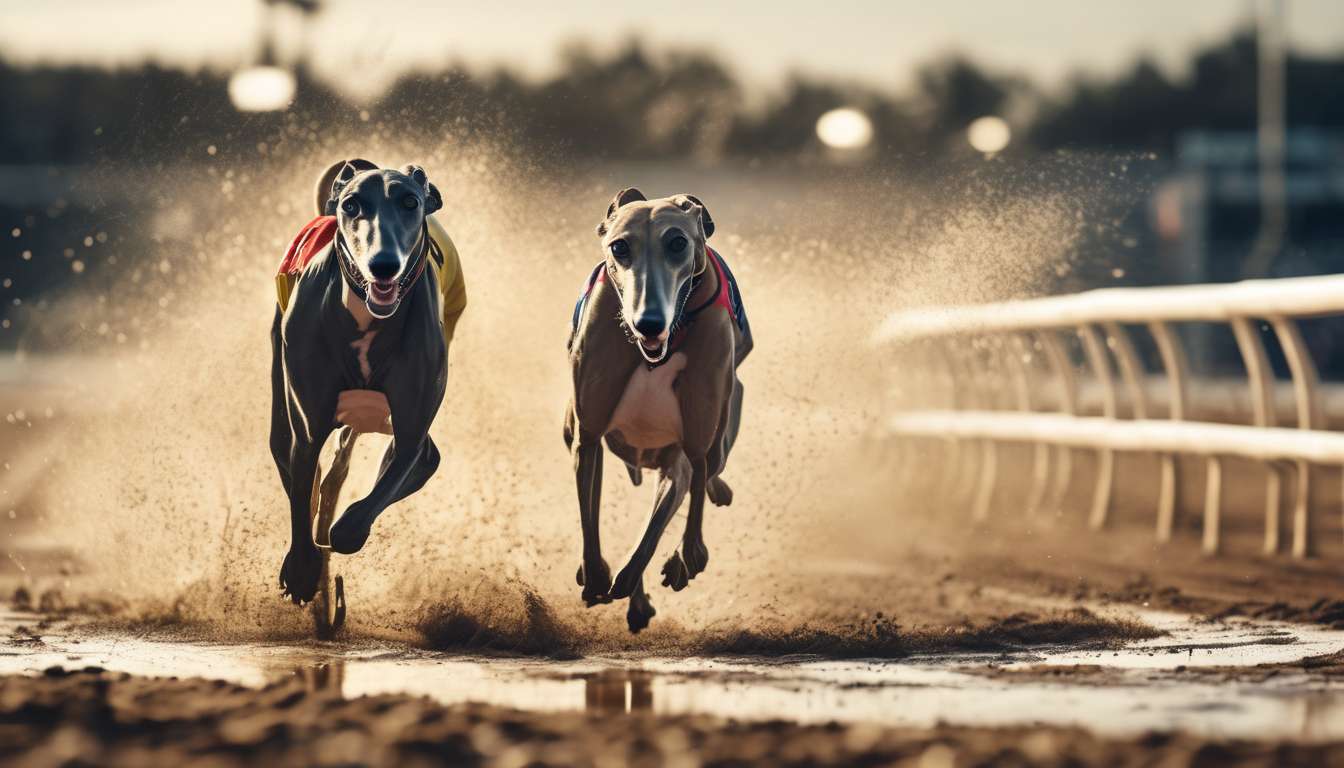Understanding the racing form is crucial in the world of dog racing. This article aims to demystify this essential tool by exploring eight proven strategies that will help us read a dog racing form like seasoned professionals.
Key Areas to Focus On:
-
Decipher Track Conditions
- Understand how different track surfaces and weather conditions can affect a dog’s performance.
-
Assess a Dog’s Past Performances
- Analyze previous race results to gauge consistency and improvement.
-
Evaluate Running Styles
- Identify whether a dog is a fast starter or a strong finisher.
-
Understand Trainers’ Tactics
- Look into a trainer’s track record and training methods for insights into potential performance.
-
Analyze the Starting Box
- Recognize how a dog’s starting position can impact its chances.
-
Review Weight Considerations
- Consider how a dog’s weight might affect its speed and stamina.
-
Examine Race Class and Grade
- Determine the level of competition and the dog’s ability to compete at that level.
-
Check for Recent Changes
- Note any recent changes in equipment, ownership, or kennel, as these can influence performance.
By focusing on these strategies, we aim to enhance our betting experience with knowledge and confidence. This approach not only helps us interpret the racing form accurately but also empowers us to make smarter choices, ultimately leading to greater success and enjoyment at the dog racing events we love.
Track Conditions Impact
Track conditions significantly influence a dog’s performance in a race. When we gather to enjoy the thrill of greyhound racing, we’re not just watching dogs run; we’re analyzing how each pup might fare under the day’s conditions. The texture, moisture level, and temperature of the track all play a crucial role in how a dog performs. It’s like a puzzle we need to solve.
Certain dogs excel in specific track conditions, while others may struggle. By examining past performances, we can identify patterns, such as:
- Dogs that thrive on wet tracks
- Dogs that prefer dry conditions
Race class also matters.
- Dogs competing at higher levels might adapt better to varying track conditions.
- Dogs in lower classes might not adapt as well.
In our community of racing enthusiasts, sharing insights about these factors helps us all feel more connected and confident. By understanding track conditions, we’re not just spectators; we’re part of the race.
Past Performance Analysis
Analyzing a dog’s previous races gives us valuable insights into how it might perform in upcoming events. By examining past performance, we can identify patterns and tendencies that might indicate future success or struggles.
Track Conditions:
It’s crucial to consider the track conditions during those races, as they can significantly impact a dog’s performance. Was the track wet, dry, or muddy? Knowing this helps us understand if a dog might have an edge or disadvantage in similar conditions.
Race Class:
Let’s also pay attention to the race class in which the dog competed. Higher race classes might mean tougher competition, and a dog’s ability to perform well in such races can signal its potential to excel.
Benefits of Analysis:
By focusing on these elements, we create a shared understanding and camaraderie with fellow enthusiasts, as we all aim to predict outcomes more accurately.
We dive deep into the statistics and stories, connecting over our shared love for the thrill and strategy of dog racing.
Running Style Evaluation
Running style plays a crucial role in understanding how a dog navigates the race. It can reveal strengths or weaknesses that might affect its performance.
As a community of enthusiasts, we know that evaluating a dog’s running style helps us predict how it might fare under different track conditions.
Key Observations:
- Some dogs excel in leading the pack right from the start.
- Others are known for their powerful finishes.
By examining past performance, we can identify patterns in a dog’s running style and how it adapts to varying conditions.
Diving Deeper:
When we analyze a dog’s running style, it’s important to consider the race class:
- Dogs competing in higher classes are likely to face tougher opponents.
- Their ability to maintain or adapt their style becomes crucial.
Recognizing these styles allows us to anticipate how a dog might handle the competition and track conditions, ultimately giving us greater insight into its potential success in upcoming races.
Trainer Tactics Insight
Understanding trainer tactics offers invaluable insights into the strategic elements that could influence a dog’s performance on race day. By examining a trainer’s approach, we can gauge:
- How they adapt to different track conditions
- How they’ve prepared their dogs for specific challenges
Trainers often adjust their strategies based on past performance, ensuring their dogs are ready to face competitors in their race class.
Key Considerations:
-
Pay attention to how trainers have historically managed dogs in similar conditions.
- Are they known for excelling in muddy tracks or perhaps on dry surfaces?
- This knowledge can help us anticipate how a dog might perform under current track conditions.
-
Observing a trainer’s success rate across various race classes also reveals how well they prepare dogs for different levels of competition.
By examining these elements, we become part of a community that shares a deeper understanding of the sport. Together, we can make more informed predictions and enjoy the thrill of the race.
Starting Box Significance
Understanding the significance of the starting box is crucial, as it can greatly influence a dog’s initial speed and positioning in a race. When we consider the dynamics of each race, the starting box is where it all begins. It’s not just about where the dog starts, but how well it can navigate its position from the get-go.
Track conditions play a significant role in a dog’s performance. These conditions can vary between:
- Wet
- Dry
- Muddy
Each condition affects the dog’s launch and footing differently.
Additionally, a dog’s past performance in specific starting boxes can offer valuable insight:
- Some dogs may excel in interior boxes.
- Others thrive on the edges.
It’s worth noting that certain boxes might be more favorable in a particular race class due to the competition’s nature.
By analyzing these factors, we can better predict outcomes and feel more connected to the racing community.
After all, understanding these nuances helps us belong to a group that appreciates the intricacies of dog racing.
Weight Influence Review
A dog’s weight can significantly impact its speed and endurance during a race, making it a crucial factor for us to consider when evaluating potential outcomes. In our community of race enthusiasts, understanding how weight influences performance helps us make more informed decisions.
Weight and Performance:
- A lighter dog might be faster off the starting line.
- A heavier dog could maintain stamina over longer distances.
However, weight’s effect isn’t isolated; it interacts with track conditions, which can either enhance or hinder a dog’s performance.
Track Conditions and Weight:
- In muddy conditions, a heavier dog might perform better due to better traction.
- On a dry track, a lighter dog might excel.
By examining past performance, we can identify patterns in how a dog’s weight has influenced its results in different race classes. Recognizing these nuances strengthens our community’s ability to predict outcomes, fostering a sense of belonging and shared expertise in the thrilling world of dog racing.
Race Class Assessment
When assessing race class, we focus on the dog’s previous performances across different competition levels to gauge its adaptability and skill. By examining past performance, we can determine how well a dog has competed under varying track conditions and against diverse fields. This gives us insight into the dog’s potential success in similar or higher race classes.
Our shared insights foster camaraderie as we discuss and share our experiences. We pay close attention to how a dog has handled different race classes in its history.
Dogs that consistently perform well in higher race classes demonstrate:
- Resilience
- Adaptability
This indicates that they might fare well again in similar situations.
Our passion for these nuances helps us form a community of knowledgeable enthusiasts who appreciate the intricacies of dog racing.
By closely analyzing:
- Race class
- Past performance
- Track conditions
we enhance our ability to make informed predictions. This shared understanding contributes to a sense of belonging in this thrilling sport.
Recent Changes Impact
Recent Changes in Racing Regulations and Track Designs
We’ve observed that recent changes in racing regulations and track designs have significantly influenced dogs’ performance and betting strategies. As a community that thrives on the thrill of the race and the camaraderie of shared insights, understanding these changes is crucial.
Track Conditions
Track conditions are now more varied than ever, with surfaces being modified to enhance safety and excitement. This means:
- We must pay extra attention to how these changes might affect a dog’s past performance.
- A dog that excelled previously on one type of track might face new challenges on another.
These variations can directly impact our betting strategies.
Race Class Adjustments
Race class adjustments also play a critical role. As regulatory bodies tweak classifications to ensure fair competition, we need to:
- Reassess how these shifts impact each dog’s standing.
- Analyze these elements together to create a more comprehensive picture of potential outcomes.
Community Engagement
Let’s continue sharing our knowledge and experiences. By doing so, we can all feel a deeper connection to the races and to each other.
What are the most common mistakes beginners make when reading dog racing forms?
When we first start reading dog racing forms, we often make mistakes that can impact our understanding. It’s common for beginners to overlook important details.
Common Mistakes:
- Focusing too much on just one factor
- Not considering the dog’s recent performance
- Not taking the time to analyze the entire form thoroughly
By avoiding these errors and taking a more comprehensive approach, we can improve our ability to read dog racing forms effectively.
Strategies for Improvement:
-
Consider Multiple Factors: Evaluate various aspects such as the dog’s past performance, track conditions, and competition.
-
Analyze the Entire Form: Spend adequate time reviewing all sections to get a holistic view.
-
Review Recent Performances: Pay attention to a dog’s recent races to gauge current form and fitness.
By implementing these strategies, we can enhance our understanding and interpretation of dog racing forms.
How does the dog’s age affect its racing performance?
As dogs age, racing performance can change significantly.
Younger dogs tend to have several advantages on the track:
- More energy
- Greater agility
These attributes can provide a competitive edge during races.
Older dogs, however, bring different strengths:
- More experience
- Greater wisdom
This can allow for better strategy during races.
Key considerations for maintaining competitiveness:
- Analyze racing performance with age in mind.
- Adjust training regimes accordingly.
- Modify racing tactics to suit age-related strengths and limitations.
By considering these factors, dogs can continue to perform well in races throughout their lives.
Are there specific patterns to look for in a dog’s winning streaks?
Examining a Dog’s Winning Streaks
When analyzing a dog’s winning streaks, it is crucial to focus on specific patterns that indicate their performance potential. Recognizing these patterns can significantly enhance our understanding of a dog’s future success in races.
Consistent Factors Influencing Success:
- Track conditions
- Race distance
- Competition level
By analyzing these trends, we can gain insights into which dogs may continue to excel in future races.
Benefits of Recognizing Patterns:
- Make more informed decisions when wagering on races.
- Increase the chances of backing a winning dog.
Understanding these consistent factors and patterns allows for better predictions and strategic wagering in dog races.
Conclusion
Now that you’ve learned the 8 proven ways to read dog racing form, you’re ready to make more informed bets and increase your chances of success at the track.
By analyzing:
-
Track Conditions
Understand how different weather and surface conditions can impact race outcomes. -
Past Performances
Review the dog’s previous races to gauge consistency and potential. -
Running Styles
Determine if a dog is a fast starter or a strong finisher to predict race dynamics. -
Trainer Tactics
Investigate the trainer’s history and strategies for insights into race preparation. -
Starting Boxes
Assess the dog’s performance from different starting positions. -
Weight Influences
Consider how a dog’s weight might affect its speed and endurance. -
Race Classes
Compare the level of competition in past races with the current race. -
Recent Changes
Note any alterations in the dog’s routine, diet, or health that could impact performance.
You’ll be equipped to make strategic decisions. So next time you’re at the races, remember these tips and watch your understanding and winnings grow.




